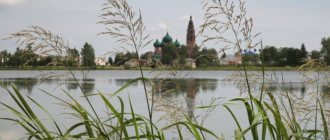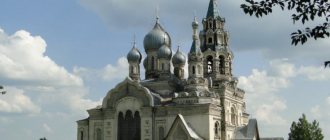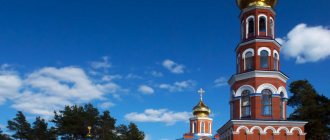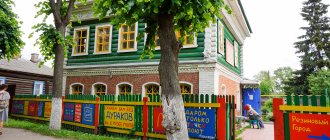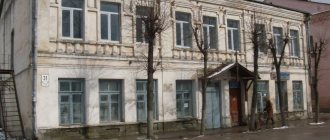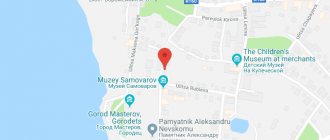Poshekhonye: areas, recreation, excursions, museums and churches, cuisine and restaurants, shopping and shops, attractions of Poshekhonye.
- New Year tours
to Russia - Last minute tours
to Russia
Poshekhonye was once mentioned even in dictionaries - as a synonym for “bear corner”. Thanks to domestic writers, local residents have acquired the reputation of being clumsy and slow-witted. But that was a long time ago. Today you need to go to Poshekhonye for the silence, peaceful solitude of city streets and free river landscapes. The idea to increase the tourist popularity of the town for the most part remains just an idea. Much to the delight of the rare travelers who still come here and can fully enjoy the charm of the real Russian outback.
Many pre-revolutionary buildings from the early 19th century have been preserved here, and the main city cathedral, Trinity Cathedral, dates back to 1717.
Poshekhonye: TOP-3 things to see in one day
To see all the sights, you need to stay in Poshekhonye for several days. If tourists visit this city “passing through,” then they should devote time to the best and most interesting places.
Holy Trinity Cathedral
- Address: Freedom Square.
Trinity Cathedral is the oldest stone structure preserved here. It was built in 1717, long before Poshekhonye was renamed into a city. Thus, the temple can be considered older than the city itself. The cathedral is made in the style of Russian architecture. The core of the composition is an expressive quadrangle, crowned with five chapters.
The drum of the central head is light, the rest are deaf. The cathedral is adjacent to a rectangular refectory and three apses. The building is decorated with a jagged cornice and semicircular kokoshniks. During one of the reconstructions, the lower windows and arches were chipped, which is why the original appearance of the building was partially lost.
In the second half of the 19th century, a four-tier bell tower was erected next to the temple, which in many ways resembles the destroyed Yaroslavl cathedral bell tower. The lower tier is richly decorated with kokoshniks and half-columns. The second and third are massive, decorated with carved arches and pilasters. They serve as the basis for a rotunda topped with a dome hemisphere.
Located in the city center, the cathedral has long been a high-rise dominant feature. During the Soviet years, a fuel oil factory settled in it, and the bell tower was used as a water tower. Industrial exploitation led to the destruction of the original interiors.
During the restoration, workers literally had to carry out fuel oil in buckets. None of the frescoes survived; the altar was destroyed. Today, the building has been returned to its original appearance, and work is underway to create new interiors. Despite the continuation of work, services are already being held in the temple.
Museum "Toptygin House"
- Address: Sovetskaya st., 4A.
“Toptygin House” is a museum dedicated to the owner of the Poshekhonsky forests - the brown bear. It was opened in 2008 and since then has been one of the most visited attractions in Poshekhonye.
In the museum you can look into a bear's den and sit in a hunting shed on a tree trunk, as well as look at stuffed brown bears.
Children will be interested in visiting the teddy bear hall. Here are toys from the beginning of the last century, the Soviet era and modern ones. Many of the cubs were donated by city residents. Each toy is a piece of childhood that holds warm memories.
In addition, in the museum you can see paintings, books, and objects of decorative and applied art related to bears.
Games, master classes, and exhibitions of fakes add variety to the excursion program. At the end, tourists will be offered to drink tea from a samovar and taste fragrant honey.
City Park
- Address: pl. Freedom.
The city park is the most popular place for walking in Poshekhonye. This is an island of peace and tranquility, in the middle of a sea of city bustle. The park has an ancient birch grove with walking paths running through it. Here you can find both ecological trails and asphalt paths convenient for cyclists and mothers with strollers.
The park occupies a picturesque corner on the banks of the Sogozha River. On one side of the birch grove there is a bridge across a narrow section of the river. You can cross the bridge back to the city. On the other side, the park overlooks the embankment, which offers an impressive panorama of the river valley. Visitors to the park note its well-groomed and cleanliness. On its territory there is a memorial complex dedicated to the heroes of the Great Patriotic War.
A little history
The village of Pertoma on the site of present-day Poshekhonye existed back in the 17th century. In 1777, Catherine II turned the village into a city with its current name and greatly contributed to its development. Since then, Poshekhonye began to gain fame as a craft town: especially a lot of gold and silver leaf was made here.
Saltykov-Shchedrin’s books “Poshekhon Stories” and “Poshekhon Antiquity” brought Poshekhony dubious fame. In them, the writer spoke about the town quite sharply and topically, even though he had never been here himself.
The name “Poshekhonye” means “the area near Shekhona” - this is one of the names of the Sheksna River. Here, in the Mologo-Sheksna depression, from time immemorial there were excellent meadows that served as pastures for livestock. This was the reason why Poshekhonsky cheese, beloved by Soviet people, could at one time be found on the shelves of almost every store in the central part of the country.
The Rybinsk Reservoir, created in 1941, seriously affected the urban landscape: the water reached the very center of Poshekhonye, and part of it was completely flooded. Like the Mologo-Sheksninskaya depression, which, alas, significantly worsened the situation with cheese. True, there was also a benefit: getting to Poshekhonye became much easier.
Today Poshekhonye is one of the smallest cities in the Russian Federation: its population is less than 6 thousand people.
The most interesting museums in Poshekhonye
There are various museums in Poshekhonye and the surrounding area. Among them there are typical historical centers and unusual exhibitions that tourists have never seen before.
People's History and Local Lore Museum
- Address: Lyubimskaya st., 20A.
The Poshekhonsky Museum of Local Lore is called a unique phenomenon of provincial culture. It was founded by citizens in 1974 to preserve culture and pay tribute to history.
Through the joint efforts of the Poshekhon residents, a collection of more than four thousand exhibits was assembled. The exhibition occupies several halls, each of which is dedicated to a special topic:
- primitive history of the region;
- history of XX and modern times;
- city life;
- crafts and trades;
- Poshekhonsky flax;
- Great Patriotic War;
- the world of plants and animals.
The Museum of History and Local Lore not only preserves the memory of ancient traditions, but also passes on folk skills from generation to generation. It has creative studios where children and adults are taught Gayutin painting, rag weaving, weaving, dancing and singing.
Museum "Vodyanoy's Residence"
- Address: Sovetskaya st., 2.
Poshekhonye stands on five rivers, which is why it was given the nickname “Yaroslavl Venice”. And in the river city, according to Slavic legends, Vodyanoy should live.
Vodyanoy “lives” in the children's library. In the room you can see numerous portraits of the owner, figurines of his frog friends, a water mill, an aquarium with live catfish and other attributes of the underwater world.
Children will especially enjoy this museum. The guide plays the role of Vodyany himself, and “Kikimora Bolotnaya” helps him. Together they give instructions, tell stories, sing songs, and at the end they treat the tourists to fish soup.
Museum "Soviet Rus'"
- Address: Poshekhonsky district, Yasnaya Polyana village.
The museum operates at the House of Culture of the village of Yasnaya Polyana. This is a kind of time machine that takes visitors back to the years of October pioneer childhood and Komsomol youth.
The halls are lined with shelves of old books, decorated with red banners, portraits and busts of Lenin. A soda machine, a school uniform, a briefcase, a pioneer bugle and toys will remind you of your childhood.
A ceremony of acceptance into pioneers is played out for visitors, in which anyone who wants to remember an exciting episode from childhood can take part.
Cultural attractions in Poshekhonye
Cultural and leisure centers will be of interest to lovers of theater and concerts. The festive atmosphere and creative atmosphere will give the evening a special touch.
Inter-settlement cultural and leisure center
- Address: st. Preobrazhensky, 1.
The cultural and leisure center occupies a former public meeting building. It was built in the second half of the 19th century. In those days, the first floor was occupied by an iron goods store and the grocery store of merchant A.F. Krundyshev, and on the second floor there was a public meeting hall and some of the city government services.
Today, the building hosts classes from 30 creative studios, as well as performances by the folk theater and the Sogozhanochka song and dance ensemble.
The institution organizes children's performances, music concerts, creative competitions, as well as holidays and open-air folk festivals. The structure also includes a children's amusement area with trampolines, electric cars and carousels, which operate in the summer.
Cinema "Yubileiny"
- Address: st. Preobrazhenskogo, 23.
The Yubileiny Cinema is one of the best cultural and leisure establishments in Poshekhonye. Every day (except Mondays) townspeople come here to spend time watching the latest Russian and foreign cinema. In addition, the cinema organizes educational events and celebrations for schoolchildren. On summer evenings, music concerts are held on the square in front of the cinema.
Yasno-Polyansky House of Culture
- Address: Poshekhonsky district, Yasnaya Polyana, Rybinskaya, 18.
The House of Culture is firmly connected with the history of the small beautiful village of Yasnaya Polyana. It was founded in 1930 as a country club and occupied premises in an abandoned church. Over the many years of its existence, the club moved from place to place, changed leaders, expanded and became more and more popular. In the 1980s it was renamed the House of Culture.
The institution's repertoire changed as Russia's ideals changed. After Perestroika, events dedicated to the history of the Soviet Union became a thing of the past and productions based on foreign works, as well as adaptations of books banned during the Soviet years, became a thing of the past.
The House of Culture continues to keep up with the times, but does not forget its origins. There is a museum dedicated to the Soviet era, and many productions tell about the history of the village. The House of Culture can safely be called the guardian of the culture of the village of Yasnaya Polyana. That is why it is so dear to local residents and interesting to their guests.
Story
The area along the Sheksna River has long been called Poshekhonye, after the old name of the river - Shekhon, and until 1341 it was part of the Yaroslavl Principality.
In the 17th century, on the site of the modern city of Poshekhonye, there was the village of Pertoma (Finno-Ugric name, based on its location on the Pertomka River, which flows into the Sogozha River, a tributary of the Sheksna). Since 1680, it housed the voivode's office. This time is characterized by the following entry: “Poshekhonsky is only a district, but there is no city.”
The city of Poshekhonye and its environs, from the “Atlas of the Yaroslavl province” of 1858
In 1777, by decree of Catherine II, the village was renamed the city of Poshekhonye and included in the Yaroslavl governorship. To strengthen the administrative role of the city, government offices, a city magistrate, a town hall and other institutions were opened here: zemstvo, district, orphan and verbal courts, police and a prison prison. The city’s coat of arms was approved: “In a golden field, crosswise, two green jagged stripes: in the middle, in a silver shield, is the coat of arms of the Yaroslavl governorship.” The two jagged stripes are also a jagged St. Andrew's cross.
Since the 18th century, gold mining has developed in Poshekhonye - the production of the thinnest sheets of gold and silver leaf. Crafts were developing: by 1862 there were 30 establishments: 6 bakeries, 3 tailors, 5 shoemakers, 4 carpenters, 2 goldsmiths, 10 forges. By the end of the 19th century, the city had a candle wax factory, five tanneries, a grain mill and three gold and silver leaf factories.
Before the October Revolution, tanneries with steam engines of the merchants Shalaev and Dubov were developing in the city, Kopotikhov's shipbuilding workshops were growing, two distilleries, a sawmill, and mills were operating.
In 1918, the city of Poshekhonye was renamed Poshekhonye-Volodarsk in memory of the revolutionary figure V. Volodarsky. During the years of Soviet power, Poshekhonye-Volodarsk became the center of a large agricultural region. New local and cooperative industry enterprises for processing raw materials and agricultural products, a creamery, a flax plant, and a fish factory, appeared. The city trains specialists for agriculture at the technical school and collective farm school, where children of collective farmers from the entire northwestern region study.
In the spring of 1941, after the creation of the Rybinsk Reservoir, the landscape of the city changed. Large expanses of water appeared, approaching close to the city center, and part of the territory was under water. The city has new opportunities for communication by water not only with regional cities, but also with Moscow and Leningrad, which increased passenger flows and cargo transportation, fishing opportunities increased, and the power system capacity increased.
In 1992, the name Poshekhonye was returned to the city.
Architecture of Poshekhonye: the most beautiful buildings
Walking around Poshekhony, it’s hard not to notice ancient buildings that attract attention with their age-old beauty.
Shopping arcades
- Address: Freedom Square, 3A.
Shopping arcades are the “calling card” of many provincial cities in Russia. Poshekhonye is no exception. The local shopping arcade was built in the 1830s and remains in excellent condition.
The architectural ensemble consists of two identical buildings, designed in the form of covered galleries, located parallel to each other.
In the old days, the ensemble included a third wooden building. Today, the shopping arcades serve the purpose for which they were built centuries ago: they house food and textile shops.
Zemstvo government building
- Address: Lyubimskaya st., 18.
The building of the zemstvo government was built at the end of the 19th century. This is a brick building in the eclectic style with pronounced features of classicism. Decorative elements include whitewashed window niches, frieze, pediment and towers. This is one of the largest public buildings in Poshekhonye.
The first floor of the building was occupied by the zemstvo library, office, archive of documents, offices of secretaries and the chairman of the council. The second floor housed a courtroom and a meeting room. Today municipal institutions operate here.
Sveshnikov's store and city government
- Address: st. Preobrazhensky, 2.
The white stone building in the eclectic style was built in the second half of the 19th century. The first floor is designed modestly, without decoration. The pharmacy store of the merchant Sveshnikov was located here. The second floor is distinguished by the stylish design of window niches and a frieze with a geometric pattern.
On the second floor there were city and town government, as well as a bank. Today the building is used in almost the same way: the first floor is occupied by a pharmacy, and the second floor by the city administration.
Women's gymnasium buildings
- Address: Proletarskaya st., 16.
In 1897, through the efforts of teacher E.S. Stoikova opened a women's gymnasium in Poshekhonye, which soon transformed into a gymnasium. Initially, the establishment was located in a wooden building, and in 1907 it moved to a new brick building.
Both buildings have survived to this day. The wooden and brick buildings were connected by a passage, which was decorated with a belfry in 1911. This element is missing.
In 1931, the complex was occupied by a collective farm youth school, which operated for four years. In 1935, a secondary school opened in its place. Currently, both buildings are occupied by a correctional boarding school.
Men's school building
- Address: st. Embankment of the Pertomka River, 9.
One of the most beautiful buildings in Poshekhonye is located on the embankment of the Pertomka River. It was erected at the end of the 19th century. The white stone house, decorated with a pediment with a colonnade and medallions, was built as a residential estate, but was later purchased by the city authorities.
It housed a men's school with a three-year education. During the Soviet years, a hospital was located here, and now there is a kindergarten.
Hotel of the Shalaev merchants
- Address: Freedom Square, 8.
A stone building with a half-tower topped with a dome and a spire catches your eye from a distance. At the beginning of the 19th century, it was occupied by a hotel opened by the merchant Shalaev. In the middle of the century the building became city property.
Since 1866, it housed a district court, and later a pedagogical institute. Today, the former hotel also serves the needs of the townspeople and houses the Education Administration Center.
Pharmacy house of Zhuravovich
- Address: st. Preobrazhenskogo, 19.
The two-story house in the constructivist style was built in the first third of the 19th century. There was a private pharmacy and hospital rooms here. Now the building is occupied by an art school.
Merchant estates of the city
For several centuries, the richest inhabitants of Poshekhonye were merchants. These people made a great contribution to the development of the city and left their mark on the pages of its history. Today, their memory is preserved in ancient estates.
Estate of merchant Dubov
- Address: st. Preobrazhenskogo, 9.
Merchant F.P. Dubov owned a tannery and a gingerbread factory. He built his house at the beginning of the 19th century. The building design was prepared by architect K.I. Russia. The estate complex included a manor house with outbuildings and outbuildings.
Only the wooden and stone outbuildings, as well as several courtyard buildings, have survived to this day. During the Soviet years, the building housed the military commissar, who is still there today.
Wooden merchant house
- Address: st. Preobrazhenskogo, 18.
This is a magnificent example of folk architecture. The two-hundred-year-old wooden building has preserved handmade openwork carvings. The finest patterns frame the windows; just above there is a frieze with medallions and floral patterns. The unique building is recognized as an object of historical and cultural heritage.
House of Merchants Shalaevs
- Address: pl. Svobody, 7.
The owners of the stylish hotel lived in an equally attractive house. A two-story stone mansion with wooden mezzanines was built at the beginning of the 19th century not far from the hotel. After the Shalaevs moved, the treasury was installed in their house.
The mansion is currently awaiting restoration. The architectural composition has been significantly changed - the mezzanines have been demolished. The only surviving decorative elements are the stucco inserts above the window frames.
Temples and monasteries of the city of Poshekhonye
Temples and monasteries located in Poshekhonye and nearby villages attract Orthodox pilgrims.
Church of the Assumption of the Blessed Virgin Mary
- Address: Voinova street.
The cemetery church was erected in 1822. The building is made of brick and was a quadrangle in the style of classicism, topped with a five-domed building. A refectory adjoined the temple from the east. The composition was completed by a two-tier bell tower with a high spire. In the 1930s, the church was looted and abandoned.
It stood desolate until the end of the 1980s, and was returned to believers in a dilapidated state. Renovation work in the temple is still underway. During the restoration, the small domes were removed. The drums were covered with slate and crowned with crosses. Despite the efforts of the architects, restoration of the historical appearance is unlikely.
Holy Dormition Hadrian Monastery
- Address: Poshekhonsky district, Andrianova Sloboda village.
In Adrianova Sloboda, which is located six kilometers from Poshekhonye, is located one of the most valuable and ancient shrines of the Poshekhonsky region - the Adrianov Monastery. It was founded in 1540 by the Venerable Martyr Adrian. Numerous spiritual exploits of this saint are captured on the pages of the history of Orthodoxy.
The first stone building on the territory of the monastery was the church in honor of the Epiphany. Later, the ensemble was supplemented by the churches of St. Nicholas the Wonderworker, the Holy Martyrs Adrian and Natalia, as well as the Assumption Cathedral. In 1699, a terrible fire destroyed all the wooden buildings, which is why the original appearance of the monastery was lost.
The monastery operated until 1918. In 1928, it became known about the underground religious activities of the monks. The brethren were repressed, and the territory of the monastery was given to the state farm.
The monastery was revived in 2000. Of the entire ensemble, only the Assumption Cathedral with its bell tower, refectory, several outbuildings and a stable survived. After the restoration, the monastery opened as a convent. It is currently in effect.
Poshekhonsky monuments and sculptures
Poshekhonye memorials are mostly dedicated to the events, ideals and heroes of the Soviet Union.
Monument to the Korolev Brothers
- Address: Freedom Square.
The history of the Great Patriotic War consists of millions of stories about people's lives. And among these stories, sometimes there are amazing cases. One of them is the story of the Korolev brothers. Future heroes grew up in the village of Ilyinskoye (Poshekhonsky district).
Seven brothers: Alexander, Sergei, Dmitry, Nikolai, Seraphim, Boris and Ilya lost their parents early. The older ones went to work in different cities, the younger ones were adopted by relatives. The brothers separated and met only at the front, when they unexpectedly found themselves in the same division. All seven brothers died in battle.
Three were missing, two were buried in mass graves. The elder brother, General Korolev, died from a head wound and was buried in Gelmyazov in Ukraine. The only one who reached Berlin was Sergei. He died in a street battle a few days before the victory.
The monument to the Korolev Brothers was opened in Poshekhonye in 1977. It is a granite slab with a bas-relief of seven soldiers leaving for the front and their mother.
The Korolevs’ mother died before she could see her sons off to the front. The woman depicted on the plate symbolizes all the women who lost children, brothers and husbands in the war. The Eternal Flame is lit at the foot of the monument.
"Avenue of Heroes"
- Address: pl. Freedom.
“Alley of Heroes” is dedicated to the thirteen Heroes of the Soviet Union, who were raised by the Poshekhon land. Steles with portraits of soldiers follow each other, as if the heroes themselves are standing in a row and looking at their fellow countrymen. The alley begins with a bas-relief of Alexander Korolev.
Directly behind it is the monument to the Korolev Brothers. Nearby you can see the monument to “Internationalist Soldiers”, as well as a memorial stone in honor of the Poshekhon soldiers who died on the battlefields of the First World War.
Cenotaph"
- Address: Voinova street.
In a quiet park there is a monument to a nameless soldier who gave his life for his Motherland. The figure of a young soldier in military uniform and with a weapon in his hands is made of concrete. Its height reaches three meters. The sculpture is placed on a cubic pedestal with a memorial plaque. There are always fresh wreaths at the foot of the memorial.
Pionersky Square
- Address: pl. Freedom.
In 1924, the first pioneer detachment was created in Poshekhonsky district. The children of tannery employees joined it. Pioneer Square appeared in 1948. With money raised by schoolchildren, plaster sculptures of a drummer, bugler and standard bearer were installed in the park.
The original Pioneer Square did not survive until the 21st century. In 2015, a sculpture of a pioneer bugler was installed in its place. In the same year, the park area was significantly transformed: alleys and benches appeared.
Monument to V.I. Lenin
- Address: Freedom Square.
The statue of Vladimir Lenin was the last monument erected during the Soviet years. The life-size sculpture of the leader is made of pink granite and installed in the city center against the backdrop of the Trinity Cathedral.
Don't miss: Sights of the Yaroslavl region
Economy
There are food industry enterprises in the city, including a cheese factory where Poshekhonsky cheese, famous throughout Russia, was made. It is currently ruined, but the governor of the Yaroslavl region plans to restore it. There is also a lumber mill. City enterprises:
- LLC "Alpha" (recreation center "Wonderful Dvor")
- State Unitary Enterprise "Avtodor" (construction and maintenance of roads)
- ATP "Poshekhonskoe" (transportation)
- Volgostroyservice LLC (construction)
- IP Plaksa (garment factory)
- "Fishchekombinat" (production of confectionery)
- LLC Poultry Farm Poshekhonskaya
- "Bread (production of lactulose and processed cheese)
- JSC "Len" (production and processing of flax)
- OJSC "Dorkommunservice Poshekhonye" (hotel services)
- OJSC "Poshekhonsky Vodokanal"
- OJSC "Poshekhonskaya heating network"
- Poshekhonsky lumber mill
The picturesque nature of the surroundings of Poshekhonye
The territory of Poshekhonye is crossed by seven rivers. Some of them are very small and inconspicuous, others are beautiful and add a picturesque touch to the city landscape.
Sogozha River
- Coordinates on the map: 58.506948, 39.116648.
Sogozha originates in the Vologda region and passes through the Volga and White Sea basins. In its lower reaches, the river flows into the Rybinsk Reservoir, due to which it expands and becomes navigable.
In the vicinity of Poshekhonye, the banks of the river are covered with mixed forest. Corners of nature are in demand among vacationers. Ecological trails are laid through the forest. Townspeople often settle down on the edges of the forest to make a fire or set up a barbecue. In some places the river is suitable for swimming.
Interesting fact: the Sogozha River gave its name to the Sugorsky (Sogozhsky) princes, belonging to the branch of the Belozersky princes.
Confluence of the Soga, Sogozha and Pertomka rivers
- GPS coordinates: 58.507462, 39.122924.
Poshekhonye is located in a unique place - at the confluence of three rivers. The rapid Sogozha is rushing towards it from the west. From the east, Soga winds like a blue ribbon. They meet in a picturesque place where the domes of the Trinity Cathedral rise on the shore.
Here they are joined by a third river - Pertomka. Together they form a small pool, the view of which opens from the embankment.
You may be interested in the sights of other cities in the Yaroslavl region:
- Yaroslavl, Tutaev, Vyatskoye village,
- Uglich, Rybinsk, Gavrilov-Yama,
- Pereslavl-Zalessky, Rostov the Great.
In the small town of Poshekhonye you can find a lot of interesting things. This place breathes history and antiquity; much here will evoke a pleasant feeling of nostalgia for childhood. Thanks to the coziness and tranquility that reign in the city, tourists will feel at home.
Poshekhonye
Sights of Poshekhonye
Poshekhonye is incredibly beautiful thanks to the large number of water resources that form a unique urban landscape.
The confluence of the Soga, Sogozha and Pertomka rivers is especially picturesque
, this is one of the most recognizable panoramas of the city, which is sometimes called the “Venice of the North”.
Sogozha River
has long been famous for its spring floods for many miles. Today, in the lower reaches it is flooded by the Rybinsk Reservoir, and in the middle, the upper banks of the river are densely populated.
The Sogozhi terraces in the upper reaches are a favorite vacation spot for both local residents and tourists from other cities.
Another notable local river is Soga
. It is famous for the dramatically changing nature of the current: at first it is relatively calm, then powerful with many rapids, and closer to Poshekhony it becomes smooth again, and the river bed widens to 250-300 meters. Soga is a favorite place for boating.
With so many rivers in the city, the location of the Vodyanoy Residence
looks very logical. It is located in the local children's library, where the lord of the waters welcomes guests along with his girlfriends, frogs and kikimores.
There are interactive programs prepared for visitors here, at the end of which everyone is treated to fish soup.
Next door is another interesting object - Toptygin House
.
It is dedicated, as you might guess, to the bear, the symbol of the Yaroslavl region and the owner of the local forests. In the museum, guests will be told many interesting facts about Toptygin, shown a real den, and when ordering an interactive program, they will even be offered to treat themselves to honey from the deck.
Two kilometers from Poshekhonye in the village of Yasnaya Polyana there is another interesting museum - Soviet Russia
. Here are the attributes of pioneer childhood: a bugle, a drum, a school uniform, and even a real soda fountain.
As an interactive program, guests are invited to participate in the solemn ceremony of admission to pioneers and attend a meeting of the collective farm board.
You can get a closer look at the history of the region at the Poshekhonsky Museum of Local Lore.
. It has several expositions: flora and fauna, urban life, trades and crafts, flax processing.
In total, the museum has more than 5,000 exhibits; it is located in the building of a former zemstvo hospital, built more than a century ago.
The place of attraction for tourists is the central Freedom Square
(before the revolution it was called Bazarnaya). Five streets radiated from it: Rybinskaya, Danilovskaya, Yaroslavskaya, Lyubimskaya and Mologskaya, which led to the corresponding cities.
In Soviet times, a monument to V.I. Lenin was erected on the square, which is noteworthy, made of pink granite.
Shopping arcades on Freedom Square attract attention
, built at the beginning of the 19th century.
Two of the three buildings have survived to this day: in one of them they sold food, in the other - dry goods. Currently, there are numerous shops in the shopping arcades.
Around Freedom Square you can see many preserved houses from the 19th century. Among them are a fire station, a police headquarters, but the most striking example of the architecture of that time can be called the house of the Shalaev merchants
.
This is a two-story building with a turret; today it houses a bank. Next door there is a three-story hotel building, which also belonged to this merchant family.
But the architectural dominant of the square is, of course, the Trinity Cathedral
, built at the beginning of the 18th century, back in the days of the village of Pertoma. This is the oldest stone building remaining in the city. Next to it stands a bell tower, erected a hundred years later.
You can climb it to see Poshekhonye from above. The views from here are amazing.
Another monument of religious architecture is the Church of the Assumption of the Blessed Virgin Mary
in white and pink tones, which was built at the beginning of the 19th century as a cemetery.
The church has two altars, as well as a small refectory and a bell tower. During Soviet times, the temple was closed, at the end of the 20th century it was handed over to believers and restored.
Approximately five kilometers from Poshekhonye along the Danilovskaya road in Adrianova Sloboda there is the famous Holy Dormition Adrian Monastery
. Initially, all the buildings in it were wooden, but after a big fire it was rebuilt in stone.
During Soviet times, the monastery was closed and the buildings were badly damaged. At the beginning of the 21st century it was handed over to believers, and currently spiritual life is being revived in it.


